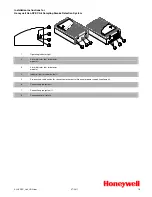
26-0874 Issue 10
Replacing Contaminated Optical Chambers
The optical chamber within the detector is not user serviceable. When an optical chamber becomes contaminated
we recommend replacing the detector. Cleaning an old chamber is not possible with this device as it is a sealed
unit. It is essential that the location of the contaminated device is verified using the device address indicated in the
event log. Do not rely on the device text alone as it is not uncommon for descriptions to be conflicting or outdated.
Once the device has been identified, see “Replacing Multipoint ASD Detectors” below.
Replacing Multipoint ASD Detectors
If a detector requires replacement after the system has been programmed and tested then proceed as follows:
Stop the loop at the control panel before replacing the detector with a new one, noting its serial number onto the
configuration sheets. Initialise the loop from the control panel and re-configure the loop devices using the
Re-config
command. This will send the programmed settings from the control panel to the loop devices. The panel should
then be reset and the device tested for all programmed modes of operation.
Device Settings
The detection and sounder modes may be configured using the relevant panel software configuration package
(OSP).
Type
Description
Detection Off:
OFF
No smoke or heat detection
Smoke Modes:
SM1
Highly thermally enhanced optical detector. Used where ionization detectors are normally fitted,
especially where there are high ceilings or a risk of free burning fires.
SM2
Thermally enhanced optical. General purpose smoke detector, to be used where optical detectors are
normally fitted, where there is a risk of a smouldering fire and for escape routes.
SM3 *
Thermally enhanced optical with smoke pulse rejection. Used where optical detectors are normally
used in positions exposed to brief concentrations of water vapour or smoke e.g from a bathroom,
kettle, etc.
Heat Modes:
HM1
Rate of rise to 58
o
C. Used where a standard rate of rise detector would be fitted, e.g. not kitchens.
HM2
Low fixed temperature 58
o
C. Used where a standard fixed temperature heat detector would normally
be fitted, e.g. suitable for domestic kitchens, etc.
HM3 * High fixed temperature 90
o
C. Used where a high fixed temperature heat detector would normally be
fitted, e.g. suitable for boiler rooms, commercial kitchens, etc.
Sound Patterns
SP0
Sounder off
SP1
Single tone, 970 Hz continually
SP2
Pulsed UK alert signal, 970 Hz 1s on, 1s off
SP3
Dual tone UK evacuate signal, 970 Hz 0.25s, 800 Hz 0.25s
SP4
Sweep up, 800 Hz to 970 Hz over 1s
SP5
Slow whoop up, 500 to 1200 Hz over 3s, 0.5s off
SP6
Sweep down, 1200 Hz to 500 Hz over 1s
SP7
Dual tone French warble, 550 Hz 0.1s, 440 Hz 400ms
NOTE Sound Patterns SP4 and SP6 are not compatible with the detector I/O facility.
Sound Volume:
L/M/H
Low, medium and high settings are available.
See the Engineering & Commissioning Manual for your control panel (Sita, Duonet or Quadnet) for further details of how to
program the above and all other device settings.
* This mode is not LPCB certified.
Testing
Due to the fact that the smoke detection modes are all ‘thermally enhanced’, it may be noticeable that on test the
devices respond more slowly than may be expected. This is perfectly normal and is due to the fact that during a
smoke test we have no heat present to cause the sensitivity to be enhanced. Please note that some makes of heat
detector test equipment will not operate with these devices due to the position of the thermistor.
Technical Data
Dimensions:
Diameter
107mm
Depth: Standard inc base
67mm
Depth: Beacon inc base
75mm
Operating temperature:
-10
o
C to +50
o
C
Voltage Range (Loop):
24 to 42V DC
Beacon Operation:
Flash Duration
5ms
Flash Interval
1s






















